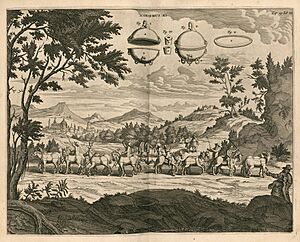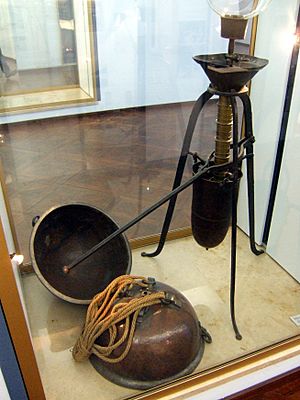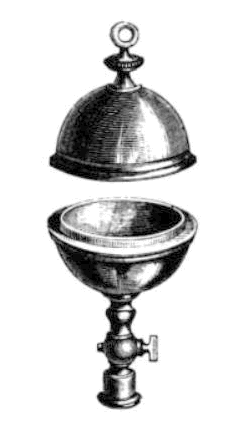Magdeburg hemispheres facts for kids
The Magdeburg hemispheres are two big copper half-spheres. They fit together perfectly. In 1654, they were used in a famous experiment. This experiment showed how powerful air pressure is.
First, the edges of the hemispheres were sealed with grease. Then, all the air inside was pumped out. This created a vacuum (an empty space). Teams of horses tried to pull the hemispheres apart, but they couldn't! When a valve was opened, air rushed back in. The hemispheres then separated very easily.
Otto von Guericke, a German scientist and mayor of Magdeburg, invented these hemispheres. He also invented the air pump. He wanted to show how his pump worked and how strong air pressure could be.
Before this, in 1643, Evangelista Torricelli had created the first artificial vacuum. This inspired Guericke to build his own vacuum pump. It used a piston and cylinder with special valves. The Magdeburg hemispheres became a popular way to teach about air pressure. They are still used in science classes today. You can see the original hemispheres at the Deutsches Museum in Munich.
The experiment also showed the world that the city of Magdeburg was recovering. Just twenty years earlier, the city had been badly damaged during the Thirty Years' War. Otto von Guericke worked hard to rebuild the city. He was both a leading scientist and a dedicated mayor.
What are the Magdeburg Hemispheres?
The Magdeburg hemispheres are about 50 centimeters (20 inches) wide. They were made to show how Guericke's new vacuum pump worked. One of the hemispheres had a tube connection. This allowed the pump to suck out the air. It also had a valve to close it off.
When the air was pumped out, the valve was closed. Then, the pump hose could be removed. The hemispheres stayed tightly together. This was because the air pressure of the surrounding atmosphere pushed on them from the outside.
The force holding them together was huge. It was like the weight of a small car or a small elephant. This showed how incredibly strong the pressure of the air around us is.
Famous Demonstrations
Guericke first showed his experiment on May 8, 1654. He performed it for the Emperor Ferdinand III in Regensburg. Thirty horses were used, in two teams of fifteen. They pulled as hard as they could. But they could not separate the hemispheres! They only came apart when the valve was opened. This let air back inside and made the pressure equal.
In 1656, Guericke did the experiment again. This time, he used sixteen horses in his hometown of Magdeburg. He also did another test. He hung the two hemispheres and removed the air. Then, he strapped heavy weights to them. The spheres still would not budge!
A scientist named Gaspar Schott was the first to write about the experiment. He described it in his book Mechanica Hydraulico-Pneumatica (1657). In 1663, the same demonstration was given in Berlin. This time, twenty-four horses were used for Frederick William, Elector of Brandenburg.
The experiment became a popular way to teach about air pressure. Many smaller copies of the hemispheres were made. They are still used in science classes today. The Otto von Guericke Society even re-enacts the original experiment around the world. For example, in 2000, sixteen horses were used in Great Torrington.
The experiment has even been shown on German postage stamps.
Scientific Discoveries
After learning about Guericke's pump, Robert Boyle and Robert Hooke built an even better air pump. They did many experiments with it. From their work, they created what is known as Boyle's law. This law explains how the volume of a gas changes with its pressure. Much later, in 1834, the ideal gas law was developed.
See also
- Horror vacui (physics)




